Miscellaneous Receipts
|
Ways and Means
|
Executive
|
|
General
|
Percent
|
General
|
Percent
|
|
Fund
|
Change
|
Fund
|
Change
|
| 1996-97 Actual |
$2,072
|
--
|
$2,072
|
--
|
| 1997-98 Estimate |
1,587
|
(23.4)
|
1,571
|
(24.2)
|
| 1998-99 Forecast |
1,447
|
(8.8)
|
1,401
|
(10.8)
|
Miscellaneous Receipts are different from the Other Taxes in that they
are not collected pursuant to any specific Article in the New York State
Tax Law. Miscellaneous Receipts are derived from a wide range of revenue
sources. There are currently six categories comprising the collections
of these receipts: Abandoned Property, Federal Grants, General Fund Refunds
and Reimbursements, Investment Income, Licenses and Fees, and Other Transactions.
All of the receipts are deposited in the General Fund.
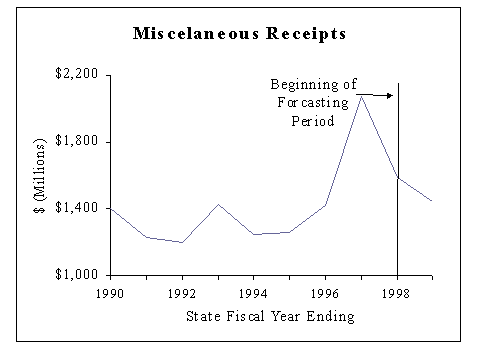
General Fund
The Committee Staff estimates that for State Fiscal Year 1997-98, Miscellaneous
Receipts will total $1,587 million, which represents a decline of $485
million, or 23.4 percent, over State Fiscal Year 1996-97. This decrease
can be mainly attributed to one-time revenue actions in the Other Transactions
category, which will not re-occur in State Fiscal Year 1997-98. This estimate
is $16 million higher than the Executive.
Also included in the Other Transactions category are law changes to
Health Care Provider Assessments which will reduce receipts by approximately
$15 million in State Fiscal Year 1997-98, and by $540 million when fully
implemented.
The Committee Staff forecast for State Fiscal Year 1998-99 is $1,447
million, which represents a reduction in overall Miscellaneous Receipts
of $140 million, or 8.8 percent, over State Fiscal Year 1997-98. This forecast
assumes a return to normal transaction patterns, especially in the Other
Transactions category, and incorporates law changes that will affect Provider
Assessments. The expected loss to the State from Provider Assessments is
approximately $40 million in State Fiscal Year 1998-99. This estimate is
$46 million higher than the Executive.
Recent Legislative History
Legislation in 1997 enacted a five-year phase-out of the Health Care Provider
Assessments. The assessments levied on hospitals and nursing homes will
begin phasing-out during State Fiscal Year 1997-98 and will be completely
phased-out in State Fiscal Year 2001-02. The estimated impact is $540 million
when fully implemented.
Motor Fuel Tax
|
Ways and Means
|
Executive
|
|
All
Funds
|
General Fund
|
General Fund Percent Change
|
All
Funds
|
General Fund
|
General Fund Percent Change
|
| 1996-97 Actual |
$472
|
$158
|
--
|
$472
|
$158
|
--
|
| 1997-98 Estimate |
492
|
166
|
5.1
|
490
|
165
|
4.4
|
| 1998-99 Forecast |
500
|
168
|
1.2
|
491
|
166
|
0.6
|
Article 12-A of the Tax Law imposes a tax upon motor fuel sold within
the State. It applies to motor fuel imported, manufactured or sold within
the state by a distributor. The tax applies to the first sale or use of
diesel. The current tax rate is 8 cents per gallon for both motor fuel
and diesel motor fuel. Four cents from the Motor Fuel Tax is deposited
in the Dedicated Highway and Bridge Trust Fund. One and three-quarters
cents from the receipts of both motor fuel and diesel motor fuel is earmarked
for the Emergency Highway Reconditioning and Preservation Fund. The remainder
is deposited in the General Fund.
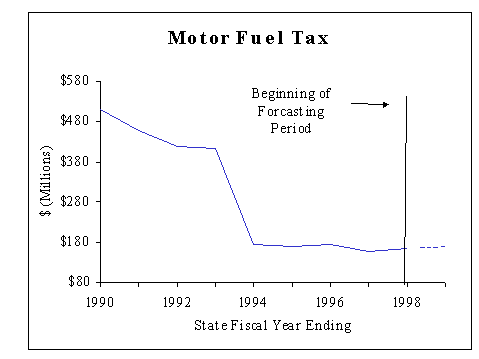
General Fund
General Fund receipts are comprised of 2.25 cents per gallon of motor fuel
and 6.25 cents per gallon of diesel motor fuel. The Committee Staff estimate
for State Fiscal Year 1997-98 is $166 million, an increase of 5.1 percent.
This estimate is $1 million higher than the Executive.
The Committee Staff forecast for State Fiscal Year 1998-99 is $168 million,
representing 1.2 percent growth over State Fiscal Year 1997-98. This estimate
is $2 million higher than the Executive.
All Funds
The Dedicated Highway and Bridge Trust Fund was created to help finance
the preservation of highways in the State. The Emergency Highway Construction
and Reconstruction Fund, and the Emergency Highway Reconditioning and Preservation
Fund were created to finance certain highway construction needs. These
transportation funds are supported in part by motor fuel receipts.
The Committee Staff estimates All Funds receipts of $492 million for
State Fiscal Year 1997-98. The Emergency Highway Construction and Reconstruction
Fund, the Emergency Highway Reconditioning and Preservation Fund and the
Dedicated Highway and Bridge Trust Fund will receive $326 million. The
Committee Staff estimate is $2 million higher than the Executive.
For State Fiscal Year 1998-99, the Highway Funds will receive $332 million,
which when combined with General Fund collections, will result in an All
Funds forecast of $500 million. This estimate is $9 million higher than
the Executive.
Recent Legislative History
The tax on diesel motor fuel was reduced by 2 cents per gallon, effective
January 1, 1996.
Motor Vehicle Fees
|
Ways and Means
|
Executive
|
|
All
Funds
|
General Fund
|
General Fund Percent Change
|
All
Funds
|
General Fund
|
General Fund Percent Change
|
| 1996-97 Actual |
$544
|
$472
|
--
|
$544
|
$472
|
--
|
| 1997-98 Estimate |
575
|
500
|
5.9
|
575
|
500
|
5.9
|
| 1998-99 Current Law |
578
|
502
|
0.4
|
578
|
502
|
0.4
|
| 1998-99 Proposed Law |
529
|
423
|
(15.4)
|
529
|
423
|
(15.4)
|
Revenue from Motor Vehicle Fees comes from over 50 different license,
registration, service, and penalty receipts. Passenger and commercial vehicle
registrations, and licensing fees are the largest components.
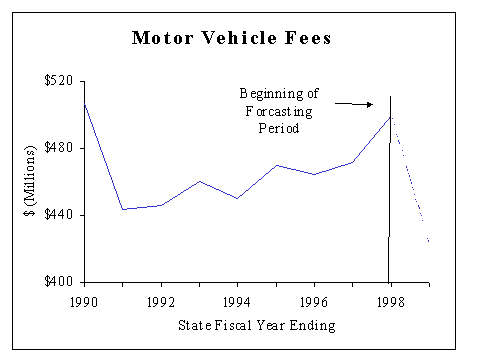
General Fund
The Committee Staff estimates Motor Vehicle Fees to total $500 million
in State Fiscal Year 1997-98, representing a 5.9 percent increase. Provisions
enacted last year, including the cessation of registration refunds, five-year
terms for driverís licenses, and photo identification fee increases explain
these additional collections. The Committee Staff estimate is the same
as the Executive.
The Committee Staff current-law forecast for State Fiscal Year 1998-99
is $502 million, which represents a 0.4 percent increase. The Committee
Staff estimate is the same as the Executive.
Legislation submitted with the Executive Budget would reduce passenger
vehicle registration by 25 percent and increase the county clerk retention
percentage to 9.3 percent. Based on these proposals, the Committee Staff
proposed-law forecast for State Fiscal Year 1998-99 is $423 million, a
decline of 15.4 percent. The Committee Staff estimate is the same as the
Executive.
All Funds
The Dedicated Highway and Bridge Trust Fund, which currently receives 20
percent of registration and fee collections would receive 25 percent on
April 1, 1998, is projected to receive $75 million in State Fiscal Year
1997-98 and $105 million in State Fiscal Year 1998-99. All Funds receipts
are expected to total $575 million in State Fiscal Year 1997-98 and $529
million in State Fiscal Year 1998-99.
Recent Legislative Changes
In State Fiscal Year 1997-98, the Legislature authorized the Department
of Motor Vehicles to set a five-year term for an original driverís license,
and also ended registration refunds.
Other Taxes
|
Ways and Means
|
Executive
|
|
General
|
Percent
|
General
|
Percent
|
|
Fund
|
Change
|
Fund
|
Change
|
| 1996-97 Actual |
$1
|
--
|
$1
|
--
|
| 1997-98 Estimate |
1
|
0.0
|
1
|
0.0
|
| 1998-99 Forecast |
1
|
0.0
|
1
|
0.0
|
Article 19 of the Tax Law allows for the levying of a 4 percent tax
on the admissions charge to racetracks and simulcast theaters and a 5.5
percent tax on the gross receipts from boxing and wrestling exhibitions,
including receipts from broadcast and motion picture rights. All of the
receipts are deposited in the General Fund.
General Fund
The Committee Staff estimates receipts from Other Taxes in State Fiscal
Year 1997-98 will total $1 million. The Committee Staff forecast for State
Fiscal Year 1998-99 is also $1 million. The State Fiscal Year 1997-98 and
1989-99 estimates are the same as the Executive.
Pari-Mutuel
|
Ways and Means
|
Executive
|
|
General
|
Percent
|
General
|
Percent
|
|
Fund
|
Change
|
Fund
|
Change
|
| 1996-97 Actual |
$42
|
--
|
$42
|
--
|
| 1997-98 Estimate |
41
|
(2.4)
|
41
|
(2.4)
|
| 1998-99 Current Law |
41
|
0.0
|
41
|
0.0
|
| 1998-99 Proposed Law |
40
|
(2.4)
|
40
|
(2.4)
|
The Racing, Pari-Mutuel Wagering and Breeding Law imposes a Pari-Mutuel
Tax on bets placed at racetracks, simulcast theaters and Off-Track Betting
(OTB) facilities. For-profit and not-for-profit racing associations, as
well as OTB Corporations, are taxed a percentage of their total betting
pools for the privilege of conducting pari-mutuel wagering. All of the
receipts are deposited in the General Fund.
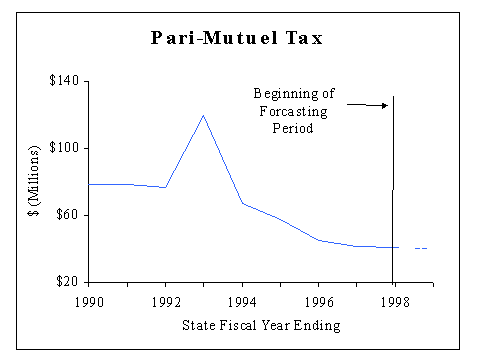
General Fund
The Committee Staff estimates that receipts will total $41 million in State
Fiscal Year 1997-98, representing a decline of 2.4 percent over last fiscal
year. This estimate is the same as the Executive.
The Committee Staff current-law forecast for State Fiscal Year 1998-99
is $41 million, representing no growth over State Fiscal Year 1997-98.
Legislation submitted with the Budget will extend the authority for
expanded simulcasting and the lower tax rates afforded to NYRA for an additional
year. Based on these proposals, the Committee Staff proposed-law estimate
for State Fiscal Year 1998-99 is $40 million. This estimate is the same
as the Executive.
Recent Legislative History
In 1997, the New York Racing Association (NYRA) was authorized to conduct
racing at Belmont, Aqueduct, and Saratoga through December 31, 2007. Furthermore,
various simulcasting provisions were extended for an additional one year,
including in-home experiment, telephone wagering and out-of-state harness
simulcasting.
NYRA was also required to use the first $2 million of annual profits
for increasing purses, and any additional profits would then be used to
reduce debt obligations.
In 1996, expanded simulcasting for when NYRA is not running, in-home
simulcasting, telephone wagering, out-of-state harness races, out-of-state
thoroughbred track simulcasting, and NYRA winter meet simulcasting were
extended for one additional year. This legislation also allowed any corporation
or association to retain a portion of the fee, not to exceed 50 percent,
for capital improvements to be used for advertising and promotional expenses,
and altered the distribution formula to permit the sharing of commissions
with regional thoroughbred tracks, in a limited way.
In 1995, expanded simulcasting, for when NYRA is not running, was extended
for one year. The reduced tax rate of 4 percent on NYRA on-track regular
bets, and the reduced tax rates at OTBs and NYRA wagers on regular, multiple
(0.5 percent), and exotic bets (1.5 percent) were extended for three years.
Taxes on NYRA on-track regular bets were reduced to 3 percent and multiple
bets to 2.5 percent for three years.
Personal Income Tax
|
Ways and Means
|
Executive
|
|
All
Funds
|
General Fund
|
General Fund Percent Change
|
All
Funds
|
General Fund
|
General Fund Percent Change
|
| 1996-97 Actual |
$16,371
|
$16,371
|
--
|
$16,371
|
$16,371
|
--
|
| 1997-98 Estimate |
18,549
|
18,549
|
13.3
|
18,547
|
18,547
|
13.3
|
| 1998-99 Current Law |
21,224
|
21,224
|
14.4
|
20,503
|
20,503
|
10.5
|
| 1998-99 Proposed Law |
21,221
|
20,497
|
10.5
|
20,500
|
19,776
|
6.6
|
Article 22 of the Tax Law imposes a Personal Income Tax on the income
of New York State individuals, estates, and trusts. Tax collections are
received through employee withholding, estimated tax payments, payments
accompanying tax returns, late payments, and assessments. All of the receipts
are deposited in the General Fund.
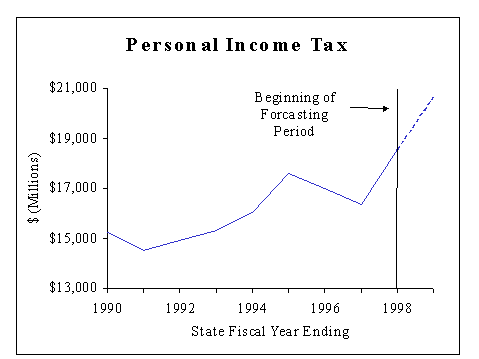
General Description
Personal Income Tax (PIT) receipts contribute over one-half of all receipts
to the General Fund. Withholding is the single largest component, comprising
roughly 80 percent of Personal Income Tax receipts.
New York Stateís definition of income closely mirrors federal rules,
which include wages, salaries, capital gains, unemployment compensation,
and interest and dividend income. The sum of these sources is Federal Adjusted
Gross Income. New York Adjusted Gross Income (NYAGI) is calculated starting
with this base, from which certain income is added or subtracted to arrive
at New York Adjusted Gross Income.
The New York standard deduction or itemized deductions, and a dependent
exemption are subtracted from NYAGI, which yields New York State Taxable
Income. Taxes are calculated based on this amount. Certain credits are
then subtracted from the calculated tax to determine total tax liability.
General Fund
The Committee Staff estimates that State Fiscal Year 1997-98 receipts will
total $18,549 million, which reflects an increase of 13.3 percent from
State Fiscal Year 1996-97. This comparison includes a $260 million Refund
Reserve transaction, which is an administrative adjustment used to transfer
General Fund surpluses from one fiscal year to the next. This estimate
is $2 million higher than the Executive.
The largest component of the Personal Income Tax is withholding. Employers
withhold tax from wages based on the estimated liability of each employee.
Receipts from withholding also include taxes withheld on bonus payments
paid to employees.
Withholding receipts are projected to total $15,225 million. This represents
an increase of $325 million, or 2.2 percent over State Fiscal Year 1996-97.
This increase is attributable to several factors, such as falling unemployment
rates combined with rising wages and bonus payments.
Estimated payment collections are projected to total $4,424 million.
This represents an increase of $568 million, or 14.7 percent over last
fiscal year. Estimated payments consist of quarterly payments made by certain
taxpayers on their estimated tax liability. These taxpayers historically
have consisted of high income earners, or people who realize significant
capital gains. The strong performance of the financial markets in 1997,
leading to high capital gains realizations, is primarily responsible for
the increase in estimated payments. Consistent with this strong growth
is the Committee Staff forecast for capital gains growth of 49.2 percent
in 1997.
The Committee Staff estimates that current-law Personal Income Tax collections
will total $21,224 million in State Fiscal Year 1998-99. This estimate
is $721 million higher than the Executive.
Withholding receipts are projected to increase to $16,482 million in
State Fiscal Year 1998-99. This represents a growth of $1,257 million or
8.3 percent over State Fiscal Year 1997-98. The Committee Staff forecast
for wage growth of 5.8 percent, coupled with no new additional tax cuts,
will allow withholding to increase by 8.3 percent.
The Committee Staff forecasts that estimated payments will total $4,915
million representing growth of $491 million or 11.1 percent over State
Fiscal year 1997-98. The performance of the financial markets is expected
to remain favorable, resulting in an increase in capital gains realization
of 18.1 percent in 1998.
Legislation submitted with the Executive Budget would dedicate $724
million in Personal Income Tax receipts to a newly created "School Tax
Relief Fund." In addition, the Executive proposes to accelerate the base
acreage amounts used in calculating the current agricultural school property
tax credit. Lastly, the Executive proposes to exclude any distribution
from the Holocaust Victimsí Fund to a Holocaust survivor or his or her
descendants from New York Adjusted Gross Income. Based on these proposals,
the Committee Staff proposed-law forecast for State Fiscal Year 1998-99
is $20,497 million.
All Funds
Legislation submitted with the Executive Budget would create the School
Tax Relief (STAR) Fund in 1998 to help finance school tax reductions under
the STAR program. In addition, it would accelerate the fully effective
level of the enhanced senior citizens school property tax exemption into
State Fiscal Year 1998-99 and accelerate the final level of the New York
City Personal Income Tax credit into Tax Year 1998 for taxpayers age 65
or more. As a result, the Executive proposes to dedicate $724 million in
General Fund revenues in State Fiscal Year 1998-99. Based on this proposal,
the Committee Staff proposed-law All Funds forecast for State Fiscal Year
1998-99 is $21,221 million, which represents a growth rate of 14.4 percent.
Recent Legislative History
In 1997, the legislature enacted several provisions under the Personal
Income Tax. They include:
-
Increasing the Child and Dependent Care Credit to 100 percent of the Federal
credit for taxpayers with adjusted gross income of $17,000 or less;
-
Creating the New York State College Choice Tuition Savings Program. New
York State residents and non-residents can establish savings accounts to
pay for qualified higher education expenses;
-
Enhancing the Farm School Property Tax credit by exempting up to the first
$30,000 of non-farm Federal gross income in the determination of eligibility
for the credit. It also provides for subtracting principal payments on
farm debt when calculating the income limit for the phase-out of the credit;
-
Extending the Employment Incentive Credit and Economic Development Zone
Employment Incentive Credit to businesses whose owners are taxable under
the Personal Income Tax; and
-
Establishing a new solar credit for residential investment in solar electric
generating equipment.
In 1996, the Legislature enhanced the Child and Dependent Care Credit by
increasing the credit to 30 percent of the Federal credit in 1996, and
to 60 percent in 1997, for taxpayers with incomes less than $10,000. The
credit is phased down to 20 percent for taxpayers with income greater than
$14,000. The credit was also made refundable.
A tax amnesty program was also established in 1996, which was provided
to taxpayers with outstanding liability for Tax Years up to and including
1994. Penalties, but not interest, were waived. Gross Personal Income Tax
revenues collected exceeded $130 million under the program.
In 1995, the Legislature enacted a three-year Personal Income Tax reduction
plan. This legislation:
-
Reduced the top rate from 7.875 percent in 1994 to 6.85 percent in 1997;
-
Accelerated the increase in the Earned Income Tax Credit (EITC) for 1996
to a fully phased in level of 20 percent of the Federal credit;
-
Reduced the EITC in 1996, and every year thereafter, by the amount of the
Household Credit used by the taxpayer;
-
Introduced an Excess Deductions Credit for 1995 only, to ensure that middle
income itemizers will not experience a tax increase due to the change from
the 5-bracket to the 4-bracket structure; and
-
Maintained the scheduled increases in the standard deduction from $9,500
for married couples filing jointly in 1994 to $13,000 in 1997.
Petroleum Business Taxes
|
Ways and Means
|
Executive
|
|
All
Funds
|
General Fund
|
General Fund Percent Change
|
All
Funds
|
General Fund
|
General Fund Percent Change
|
| 1996-97 Actual |
$968
|
$141
|
--
|
$968
|
$141
|
--
|
| 1997-98 Estimate |
975
|
113
|
(19.9)
|
958
|
111
|
(21.3)
|
| 1998-99 Forecast |
978
|
98
|
(13.3)
|
966
|
97
|
(12.6)
|
Article 13-A of the Tax Law imposes a tax on petroleum businesses (PBT)
for the privilege of extracting, producing, refining, manufacturing or
importing petroleum in New York State. Imposition of the tax occurs at
different points in the distribution chain, depending upon the type of
petroleum product.
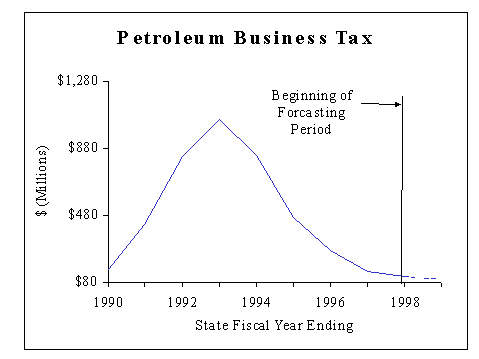
General Fund
The Committee Staff projects receipts in State Fiscal Year 1997-98 will
total $113 million, a decline of 19.9 percent. The elimination of the Business
Tax Surcharge, as well as additional tax cuts, more than offset the increased
tax rates, which became effective January 1, 1997. Moreover, the additional
dedication of General Fund receipts is reflected in the negative growth.
This estimate is $2 million higher than the Executive.
The Committee Staff forecasts receipts to decline by an additional 13.3
percent, to a total of $98 million in State Fiscal Year 1998-99. Additional
dedication of General Fund receipts to the Dedicated Highway and Bridge
Trust Fund and to the Mass Transportation Operating Assistance Fund (MTOAF),
and the continuation of the tax cuts implemented in State Fiscal Year 1996-97
are reflected in the negative growth. This estimate is $1 million higher
than the Executive.
All Funds
The General Fund, MTOAF, and other dedicated receipts comprise the All
Funds estimate for the Petroleum Business Tax. In State Fiscal Year 1997-98,
All Funds receipts are estimated to total $975 million, a 0.7 percent increase,
due to the economic expansion and stable oil prices. Receipts for State
Fiscal Year 1998-99 are projected to total $978 million, a 0.3 percent
increase.
Recent Legislative History
In 1997, additional refunds and credits were created for the Petroleum
Business Tax and Motor Fuel Taxes for commercial vessels where the purchases
of fuel exceed consumption of fuel in the State.
In 1996, legislation was enacted that: reduced the tax on "railroad
diesel" by 7 cents per gallon; eliminated the Petroleum Business Tax on
non-automotive diesel motor fuel and residual used in manufacturing; increased
the basic credit or reimbursement on residual petroleum products or diesel
fuel for utility companies by 0.5 cents per gallon; reduced the automotive
diesel motor fuel component by 1.75 cents per gallon; and changed the distribution
of revenues from the Petroleum Business Tax to hold the transportation
funds and MTOAF harmless from these reductions. Furthermore, other provisions
included: the reimbursement of the Petroleum Business Tax on aviation and
kero-jet fuel purchased in-state but consumed out-of-state; expanded the
time for which taxpayers may claim a refund for taxes paid on fuel purchased
in-state but consumed out-of-state; and allowed taxpayers to file for refunds
for taxes paid up to four years after the tax was paid.
In 1995, the reduction of the Petroleum Business Tax rate and the elimination
of the supplemental tax for aviation gasoline and kero-jet fuel were enacted.
In addition, fuel consumed by not-for-profit organizations was given a
full exemption.
In 1994, legislative actions repealed the 10-cent tax on lubricating
oil; provided for the refund of sales on accounts determined to be uncollectible;
exempted manufacturers from the Petroleum Business Tax supplemental tax;
provided for a commercial heating oil credit against the Petroleum Business
Tax; exempted farm and greenhouse use of diesel and residual fuel from
the Petroleum Business Tax when the fuel is delivered to the farm; postponed
potential downward indexing; restricted Petroleum Business Tax rate increases
by capping them at 5 percent; provided for refunds for commercial fishing
vessels on diesel motor fuel and motor fuel,; and granted a partial exemption
for not-for-profit organizations for the supplemental Petroleum Business
Tax and the Business Surcharge Tax.
Real Estate Gains Tax
|
Ways and Means
|
Executive
|
|
General
|
Percent
|
General
|
Percent
|
|
Fund
|
Change
|
Fund
|
Change
|
| 1996-97 Actual |
$42
|
--
|
$42
|
--
|
| 1997-98 Estimate |
30
|
(28.6)
|
30
|
(28.6)
|
| 1998-99 Forecast |
19
|
(36.7)
|
19
|
(36.7)
|
The Real Estate Gains Tax is imposed, pursuant to Article 31-B of the
Tax Law, at a rate of 10 percent on the gain from certain large realty
transfers, where the consideration is $1 million or more. All of the receipts
are deposited into the General Fund.
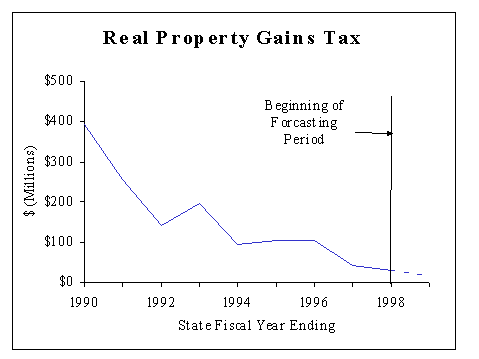
General Fund
The Committee Staff estimates that Gains Tax receipts will total $30 million
in State Fiscal Year 1997-98, a decline of 28.6 percent over State Fiscal
Year 1996-97. This reflects the repeal of the Gains Tax, effective for
transfers that take place after June 15, 1996. State Fiscal Year 1997-98
primarily reflect collections from transactions that occurred prior to
June 15, 1996. This estimate is the same as the Executive.
The Committee Staff forecasts total receipts of $19 million in State
Fiscal Year 1998-99, a decline of 36.7 percent. Despite the repeal of the
Gains Tax in 1996, revenues will continue to accrue due to audits and installment
payments from prior year transfers. This estimate is the same as the Executive.
Recent Legislative History
Chapter 309 of the Laws of 1996 repealed the Gains Tax, retroactive to
all conveyances of property that took place after June 15, 1996.
Real Estate Transfer Tax
|
Ways and Means
|
Executive
|
|
All
Funds
|
General Fund
|
General Fund Percent Change
|
All
Funds
|
General Fund
|
General Fund Percent Change
|
| 1996-97 Actual |
$194
|
$108
|
--
|
$194
|
$108
|
--
|
| 1997-98 Estimate |
236
|
0
|
(100.0)
|
225
|
0
|
(100.0)
|
| 1998-99 Forecast |
243
|
0
|
0.0
|
237
|
0
|
0.0
|
The Real Estate Transfer Tax, Article 31 of the Tax Law, is levied
on real property transfers where the value of the interest in the property
exceeds $500. The rate is $2 for each $500, or a fraction thereof, of net
consideration. An additional tax of 1 percent is levied on residential
transfers where the consideration is over $1 million. The party that sells
the property pays the tax.
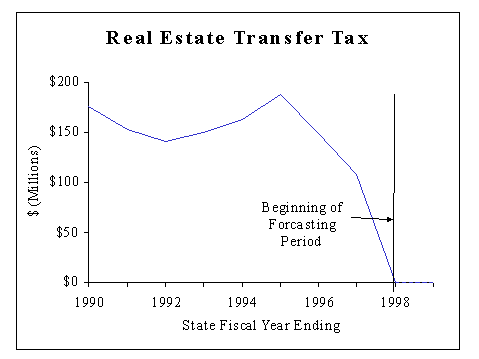
General Fund
All Real Estate Transfer Tax revenues are dedicated for environmental programs.
All Funds
Under current law, $87.0 million in Real Estate Transfer Tax revenue is
dedicated to the Environmental Protection Fund, and all remaining revenue
is dedicated to pay debt service on the Clean Air/Clean Water Bond Act.
Therefore, General Fund collections from the Real Estate Transfer Tax will
total $0 in both State Fiscal Years 1997-98 and 1998-99.
For State Fiscal Year 1997-98, All Funds Real Estate Transfer Tax revenue
is estimated to total $236 million. Collections in the current fiscal year
have been relatively strong, due in part to relatively stable mortgage
interest rates, and slow but steady economic growth. This estimate is $11
million higher than the Executive.
The Committee Staff estimates that Real Property Transfer Tax receipts
will total $243 million, in State Fiscal Year 1998-99. This forecast is
based on projections of moderate growth in the economy in 1998. This estimate
is $6 million higher than the Executive.
Legislation submitted with the Budget will increase the deposit of revenues
to the Environmental Protection Fund by $25 million per year in State Fiscal
Year 1998-99.
Recent Legislative History
In 1996, legislation was enacted that extended the current New York State
Real Estate Transfer and New York City Real Estate Transfer Tax reductions
for Real Estate Investment Trusts (REITs). Further, it temporarily expanded
the application of the REIT provisions to transfers to existing REITs,
and changed the 40 percent interest requirement to 50 percent for existing
REITs. It also eliminated the "seventy-five percent" rule for existing
REITs until September 1, 1998. On the expiration date, the present REIT
provisions again become effective permanently. This change is expected
to have a minimal effect on overall collections.
Also in 1996, voters approved the Clean Air/Clean Water Bond Act. As
part of the Act, revenues in excess of the $87.0 million already dedicated
to the Environmental Protection Fund will be used to pay debt service on
the Bond Act. Any funds in excess of that which is necessary to make debt
service payments will be transferred back to the General Fund and show
up as transfers to the General Fund.
Regional Business Tax Surcharge
|
Ways and Means
|
Executive
|
|
All
|
Percent
|
All
|
Percent
|
|
Funds
|
Change
|
Funds
|
Change
|
| 1996-97 Actual |
$560
|
--
|
$560
|
--
|
| 1997-98 Estimate |
563
|
0.5
|
539
|
(3.8)
|
| 1998-99 Forecast |
566
|
0.5
|
537
|
(0.4)
|
The Regional Business Tax Surcharge is comprised of a 17 percent surcharge
applied on the portion of Article 9-A (Corporate Franchise), Article 9
(Corporations and Utilities), Article 33 (Insurance), and Article 32 (Bank)
taxes attributable to business activity carried on within the Metropolitan
Commuter Transportation District (MCTD). This district consists of seven
counties (Dutchess, Nassau, Orange, Putnam, Rockland, Suffolk, and Westchester)
and the City of New York.
All Funds
Collections from the surcharge are deposited into the Mass Transportation
Operating Assistance Fund, associated with the Metropolitan Transportation
Authority.
The Committee Staff estimates State Fiscal Year 1997-98 revenues will
total $563 million, representing 0.5 percent growth over State Fiscal Year
1996-97. The estimate is based on earnings for businesses, especially for
the financial sector, which is a very significant element within the MCTD.
This estimate is $24 million higher than the Executive.
The Committee Staff forecast for State Fiscal Year 1998-99 totals $566
million, also representing growth of 0.5 percent. This estimate is $29
million higher than the Executive.
Recent Legislative History
In 1997, the State extended the surcharge for an additional 4 years to
December 31, 2001.
Sales Tax
|
Ways and Means
|
Executive
|
|
All
Funds
|
General Fund
|
General Fund Percent Change
|
All
Funds
|
General Fund
|
General Fund Percent Change
|
| 1996-97 Actual |
$7,261
|
$5,225
|
--
|
$7,261
|
$5,225
|
--
|
| 1997-98 Estimate |
7,575
|
5,453
|
4.4
|
7,575
|
5,458
|
4.5
|
| 1998-99 Current Law |
7,835
|
5,639
|
3.4
|
7,944
|
5,721
|
4.8
|
| 1998-99 Proposed Law |
7,815
|
5,624
|
3.2
|
7,919
|
5,702
|
4.5
|
The Sales and Compensating Use Tax, Article 28 of the Tax Law, is a
broad-based consumption tax levied on the sale of tangible personal property,
excluding items such as food and products used in manufacturing, and including
a limited number of services such as trash removal and interior design
services. The tax is also imposed on a limited number of services. The
State Sales Tax rate is 4.0 percent.
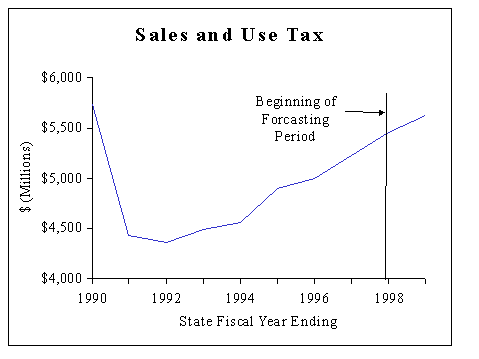
General Fund
The Committee Staff Sales Tax estimate for State Fiscal Year 1997-98 is
$5,453 million. This represents growth of $228 million, or 4.4 percent,
over the collections in State Fiscal Year 1996-97. This estimate takes
into account strong growth in the current fiscal year, particularly in
durable goods orders and retail sales. It also considers factors such as
levels of consumer confidence, strong employment and wage growth, and the
tax cuts that were enacted as part of the 1996 and 1997 budgets. This estimate
is $5 million lower than the Executive.
The Committee Staff current-law forecast for State Fiscal Year 1998-99
is $5,639 million, which represents growth of $186 million, or 3.4 percent.
This estimate is based on moderated strength in the retail sector, led
by a slow-down in durable goods orders, moderate gains in employment, continued
strong wage growth, and the maintenance of relatively high levels of consumer
confidence. This estimate also accounts for tax cuts enacted in the 1996
and 1997 State budgets. The current-law forecast is $82 million lower than
the Executive.
Legislation submitted with the Executive Budget would include footwear
in the clothing exemption for the September 1998 back-to-school week and
add an additional week in January 1999, when clothing and footwear costing
less than $500 would be exempt from the State Sales Tax. Based on these
proposals, the Committee Staff proposed-law forecast for State Fiscal Year
1998-99 is $5,624 million, which represents an increase of 3.2 percent.
All Funds
The All Funds category is comprised of the General Fund, the Local Government
Assistance Tax Fund, and the Mass Transportation Operating Assistance Fund
(MTOAF). The Committee Staff estimates that All Funds receipts in State
Fiscal Year 1997-98 will total $7,575 million. Current-law All Funds receipts
in State Fiscal Year 1998-99 are projected to total $7,835 million. The
Committee Staff estimates proposed-law All Funds receipts of $7,815 million,
which represents a difference of $20 million.
One percent of the State Sales Tax is dedicated to pay for the debt
service of the Local Government Assistance Corporation (LGAC), which was
created in 1990 to eliminate the annual Spring Borrowing. Once the debt
service obligations are paid, any remaining excess revenue is then transferred
back to the General Fund. In State Fiscal Year 1997-98, $1,818 million
will be dedicated to LGAC. The current-law forecast for State Fiscal Year
1998-99 is expected to yield an LGAC dedication of $1,880 million; $1,875
million for the proposed-law dedication.
In 1981, MTOAF was created to help finance the Stateís public transportation
system. A portion of the revenue is derived from the 0.25 percent Sales
Tax that is imposed in the Metropolitan Commuter Transportation District
(MCTD). In State Fiscal Year 1997-98, the Committee Staff estimates that
$304 million will be deposited in MTOAF and $316 million will be deposited
in State Fiscal Year 1998-99 (current and proposed-law), from the 0.25
percent Sales Tax in the MCTD.
Recent Legislative History
In 1997, the Legislature authorized articles of clothing costing less than
$100 per item to be exempt from the State Sales Tax for the week of September
1 through September 7, 1997. A local option was provided for municipal
governments that levy a local sales tax. A revenue loss of $20 million
is expected in State Fiscal Year 1997-98. This exemption will also apply
to the same period in September 1998 (a $25 million loss in State Fiscal
Year 1998-99), before becoming fully effective December 1, 1999. The fully
implemented cost is estimated to be approximately $430 million.
An additional one-week exemption was provided for the week of January
17 through January 23, 1998. Articles of clothing and footwear costing
less than $500 per item were exempt from the State Sales Tax. All municipalities
that levy a local sales tax, except the City of White Plains, exercised
the local option.
The actual Sales Tax collectors are the merchants who sell taxable goods.
In an effort to compensate those merchants for complying with State regulations,
the State allows them to retain a small portion of the taxes they collect.
Vendors are permitted to take an allowance of 1.5 percent, subject to a
$100 per quarter ($400 per year) cap. This allowance was increased in 1997,
to 3.5 percent of the State Sales Tax collected, subject to a higher maximum
cap of $150 per quarter ($600 per year). The increase shall apply to Sales
Tax quarters commencing on March 1, 1999. The estimated cost is $26 million.
Miscellaneous Sales Tax exemptions that were enacted in 1997 include
the following:
-
Motor coach buses and their parts, equipment, lubricants (but not fuel),
and all associated repair and maintenance services;
-
Coin-operated, self-service car washes;
-
Coin-operated luggage carts;
-
Coin-operated photocopier sales of 50 cents or less;
-
Bulk vending machine sales of 50 cents or less and all food and drink (including
hot drinks) sold through coin-operated vending machines;
-
Circus admissions;
-
Wine used at wine-tasting events;
-
Receipts from the parking, garaging, or storing of motor vehicles in condominium
and cooperative housing units; and
-
Emissions inspection equipment utilized by motor vehicle inspection stations.
All of the above exemptions became effective December 1, 1997. In addition,
current exemptions for alternative fuel vehicles were extended for an additional
5 years and Article 15 of the Tax Law was repealed. The total estimated
loss of these provisions is approximately $7 million in State Fiscal Year
1997-98, and $13 million in State Fiscal Year 1998-99.
Utility Tax
|
Ways and Means
|
Executive
|
|
All
Funds
|
General Fund
|
General Fund Percent Change
|
All
Funds
|
General Fund
|
General Fund Percent Change
|
| 1996-97 Actual |
$1,629
|
$1,577
|
--
|
$1,629
|
$1,577
|
--
|
| 1997-98 Estimate |
1,620
|
1,547
|
(1.9)
|
1,603
|
1,530
|
(3.0)
|
| 1998-99 Forecast |
1,546
|
1,473
|
(4.8)
|
1,511
|
1,437
|
(6.1)
|
The Corporations and Utilities Tax, Article 9 of the Tax Law, imposes
a gross receipts and franchise tax on regulated utilities and industries.
The major industries subject to this tax are utilities (gas, electric,
water and steam), telecommunications (telephone and telegraph), and transportation
industries (trucking and railroad). The majority of revenue from Article
9 is deposited into the General Fund. However, a portion of the tax imposed
on the capital stock of telecommunications and transportation companies
is dedicated to the Mass Transportation Operating Assistance Fund (MTOAF).
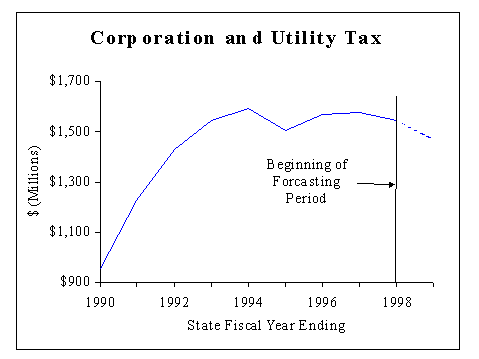
General Fund
The Committee Staff projects receipts for State Fiscal Year 1997-98 to
total $1,547 million, a decline of 1.9 percent. Though there has been a
slight increase in consumption, rate reductions, enacted in 1996, in the
tax on capital stock imposed by Sections 183 and 184 of the Tax Law on
trucking and railroad companies, is a contributing factor to this decline.
Also, to offset the revenue loss to MTOAF due to rate reductions, the percentage
of dedication to MTOAF from Sections 183 and 184 has increased, thereby
reducing General Fund receipts. This estimate is $17 million higher than
the Executive.
The Committee Staff forecast for State Fiscal Year 1998-99 is $1,473
million, representing a decline of 4.8 percent. This decline is attributable
to a series of tax reductions. In 1997, the Legislature reduced the tax
rate on the gross receipts from the sale of utilities and telecommunications
services from 3.5 percent to 2.5 percent (Section 186-a and Section 186-e).
In addition, utility companies were provided a tax credit for participating
in the Power For Jobs program, which was established to enhance job creation
and retention. Further, in 1996, trucking and railroad companies received
a rate reduction from 0.75 percent to 0.6 percent on their gross receipts
beginning in Tax Year 1997 (Sections 183 and 184). These measures are estimated
to reduce Utility Tax receipts by $90 million in State Fiscal Year 1998-99.
This estimate is $36 million higher than the Executive.
All Funds
Through a special revenue fund, the Metropolitan Transportation Authority
(MTA) receives a dedicated share of collections from Sections 183 and 184
of the Tax Law. For April 1, 1996 through December 31, 1996, 48.9 percent
of revenues collected under these two sections of law was dedicated, and
49.5 percent was dedicated for Calendar Year 1997. The amount dedicated
will increase to 50.5 percent for Calendar Year 1998. All Funds receipts
are expected to total $1,620 million in State Fiscal Year 1997-1998, and
$1,546 million in State Fiscal Year 1998-1999.
Recent Legislative History
In 1997, legislation that was enacted included:
-
A rate reduction for Sections 186-a and 186-e of Article 9 from 3.5 percent
to 3.25 percent on October 1, 1998. A further reduction of the rate to
2.5 percent will occur on January 1, 2000;
-
A rate reduction for the Gross Earnings Tax in Section 184 from 0.75 percent
to 0.375 percent. For transportation companies the rate reduction is from
0.6 percent to 0.375 percent. The effective date is July 1, 2000;
-
For the purpose of computing the MTA Surcharge on the above, Sections 184,
186-a and 186-c, the tax shall be computed as if the rate reduction had
not occurred; and
-
The formula for the distribution of revenues from Sections 183 and 184
will be changed to maintain the required funding level for the MTOAF.
In 1996, the tax rate on trucking and railroad industries, under
Section 184 of Article 9, was reduced from 0.75 percent to 0.6 percent
of gross receipts starting in Tax Year 1997. Further, these industries
have the option of converting from taxation under Article 9 to Article
9-A beginning in Tax Year 1998 and thereafter. There was no fiscal impact
for State Fiscal Year 1996-97, and a reduction of $6 million is estimated
for State Fiscal Year 1997-98.
In 1995, Telecommunications Tax reform was enacted in response to a
Court of Appeals decision. The major implications involved the moving of
the access charge deduction from long distance companies to local telephone
companies, updating the computation of the tax (Goldberg methodology) for
providing telecommunication service, and the agreement that long distance
companies would forgo refunds due to them.
In 1994, the dedicated portion of receipts to the MTA was temporarily
reduced for two years. The "undedicated" revenues were deposited in the
General Fund.










